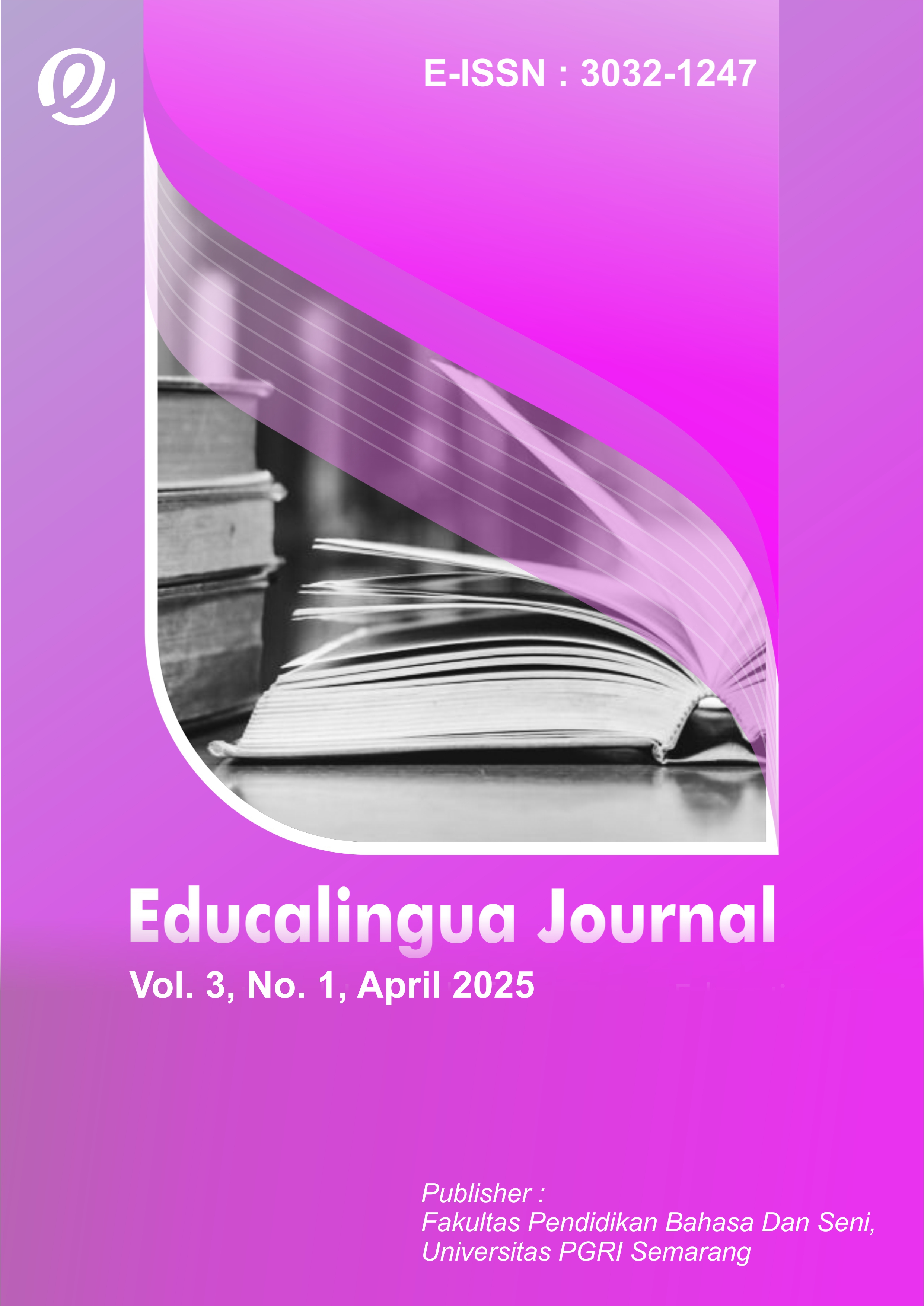Empowering Young Minds: The Impact of Philosophy for Children (P4C) and Picture Storybooks on EFL Learners’ Anxiety and Reading Comprehension
DOI:
https://doi.org/10.26877/1gp5ft34Keywords:
philosophy for children, picture storybooks, anxiety, reading, English learningAbstract
This study examines how combining Philosophy for Children (P4C) and picture storybooks can reduce English learning anxiety and improve reading comprehension among Indonesian EFL students. Based on Vygotsky’s sociocultural theory and affective pedagogy, the approach addresses both emotional and cognitive aspects of learning. Using a quasi-experimental mixed-methods design, 121 fourth-semester English Department students were divided into experimental and control groups. The experimental group received lessons that used philosophical dialogue and visual storytelling to encourage critical thinking and emotional involvement. Results showed that this approach significantly lowered students' anxiety and improved their reading comprehension and motivation. Qualitative data also revealed that students felt safer and more engaged, which helped them connect personally with the texts. The study shows that student-centered, interdisciplinary teaching can support both language learning and emotional well-being. It offers useful insights for EFL teachers and curriculum developers aiming to create more meaningful and supportive learning environments.
References
Ab Wahab, M. K., Zulkifli, H., & Abdul Razak, K. (2022). Impact of philosophy for children and its challenges: a systematic review. Children, 9(11), 1671.
Alhamdawee, N. O. (2022). Importance of motivation in learning english language. Humanities & Natural Sciences Journal, 3(1), 902-910.
Biney, I. K. (2023). Adult education and entrepreneurship: getting young adults involved. Journal of Innovation and Entrepreneurship, 12(1), 13.
Bergdahl, N. (2025). Second language learning designs in online adult education. Computer Assisted Language Learning, 38(1-2), 1-29.
Darmawan, L. A., & Wuryandani, W. (2022). How Picture Storybook Improve Creative Thinking Skills and Learning Outcomes of Elementary School Students?. Journal of Education Research and Evaluation, 6(3), 529-537.
Dovchin, S. (2021). Translanguaging, emotionality, and English as a second language immigrants: Mongolian background women in Australia. Tesol Quarterly, 55(3), 839-865.
Febriyanti, E. R., & Hidayat, F. (2023). Developing Picture Storybook in English with Wetlands Theme for Young Learners. Acitya: Journal of Teaching and Education, 5(1), 171-187.
Guan, L., Li, S., & Gu, M. M. (2024). AI in informal digital English learning: A meta-analysis of its effectiveness on proficiency, motivation, and self-regulation. Computers and Education: Artificial Intelligence, 7, 100323.
Halwani, N. (2017). Visual aids and multimedia in second language acquisition. English language teaching, 10(6), 53-59.
Isha, S. R., Azam, M. N. D., & Daud, M. N. (2022). A systematic review: identifying research gaps in emotional intelligence development using storybook as a learning tool,„. International Journal of Academic Research in Business and Social Sciences, 12(10).
Kanani Harandi, S., Nourian, M., Noroozi, D., & Abaei Koopaei, M. (2021). The effect of philosophy for children curriculum on the growth of students' creativity. Thinking and Children, 12(1), 203-230.
Lam, C. M. (2023). A philosophy for children approach to professional development of teachers. Cambridge Journal of Education, 53(1), 1-17.
Liu, M., & Wu, B. (2021). Teaching anxiety and foreign language anxiety among Chinese college English teachers. Sage Open, 11(2), 21582440211016556.
Meirizal, Y., Hambali, S., Zakaria, D. A., Hidayat, Y., & Bernhardin, D. (2023). The Implementation of Flip Book-Based Audio-Visual Media in the Learning Basketball Lay-Up Shoot. Musamus Journal of Physical Education and Sport (MJPES), 6(1), 140-147.
Moskowitz, S., & Dewaele, J. M. (2021). Is teacher happiness contagious? A study of the link between perceptions of language teacher happiness and student attitudes. Innovation in Language Learning and Teaching, 15(2), 117-130.
Nosrati Heshi, K., Abaspour, N., Eskandari, A., & Naderi, Z. (2022). The effectiveness of the implementation of teaching philosophy to children program on the attitude toward creativity and achievement motivation of girl students in Isfahan. Educational and Scholastic studies, 11(1), 351-376.
Philominraj, A., Jeyabalan, D., & Vidal-Silva, C. (2017). Visual Learning: A Learner Centered Approach to Enhance English Language Teaching. English language teaching, 10(3), 54-62.
Prastikawati, E. F., Wiyaka, W., & Adi, A. P. K. (2020). Online backchannel as a formative assessment in improving writing skills. Journal on English as a Foreign Language, 10(2), 359-384.
Rasool, U., Qian, J., & Aslam, M. Z. (2023). An investigation of foreign language writing anxiety and its reasons among pre-service EFL teachers in Pakistan. Frontiers in Psychology, 13, 947867.
Rorimpandey, R. (2023). Application of visual media pop-up book in english learning in elementary school. Journal of English Culture, Language, Literature and Education, 11(1), 106-124.
Sajadipoor, F., & Yavari, F. (2024). The effectiveness of implementing a philosophy for children program based on Blended learning approach on Critical thinking of the second elementary school students: A new strategy for inclusive education. Thinking and Children, 14(2), 173-200.
Sofian, R. F., & Anggraeni, A. (2021). An analysis the use of visual media in teaching English to young learners. PROJECT (Professional Journal of English Education), 4(4), 622.
Tsang, A., & Yeung, S. S. S. (2024). The Interrelationships Between Young English-as-a-Foreign-Language (EFL) Learners’ Perceived Value in Reading Storybooks, Reading Self-efficacy, and Proficiency. SAGE Open, 14(4), 21582440241293044.
Tu, X. (2021). The role of classroom culture and psychological safety in EFL students' engagement. Frontiers in Psychology, 12, 760903.
Ünal Gezer, M. (2021). Storybooks, Songs, and Games: Tools to Boost Early Literacy Development in Primary English Classrooms. International Online Journal of Education and Teaching, 8(4), 2683-2700.
Vansieleghem, N., & Kennedy, D. (2011). What is philosophy for children, what is philosophy with children—after Matthew Lipman?. Journal of Philosophy of Education, 45(2), 171-182.
Vu, N. N., Hung, B. P., Van, N. T. T., & Lien, N. T. H. (2021). Theoretical and instructional aspects of using multimedia resources in language education: A cognitive view. Multimedia Technologies in the Internet of Things Environment, Volume 2, 165-194.
Vygotsky, L. S. (1978). Mind in society: The development of higher psychological processes (Vol. 86). Harvard university press.
Wei, L. (2023). Artificial intelligence in language instruction: impact on English learning achievement, L2 motivation, and self-regulated learning. Frontiers in psychology, 14, 1261955.
Xu, A. (2022). The importance of philosophy for children. International Journal of New Developments in Education, 4(7), 21-34.
Yüceer, D., & coşkun keskin, S. (2023). A practical look at the concept of freedom with a philosophy approach for children in early childhood. Childhood & Philosophy, 19.





